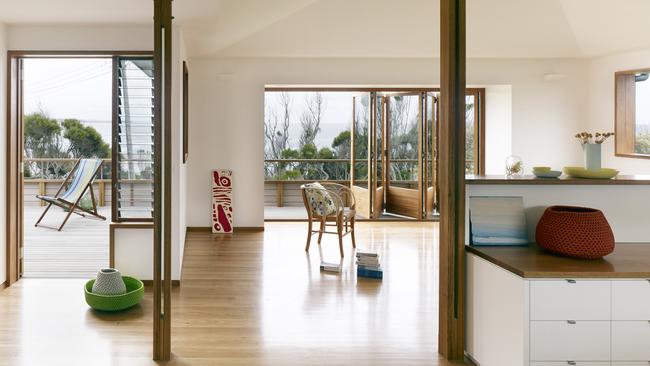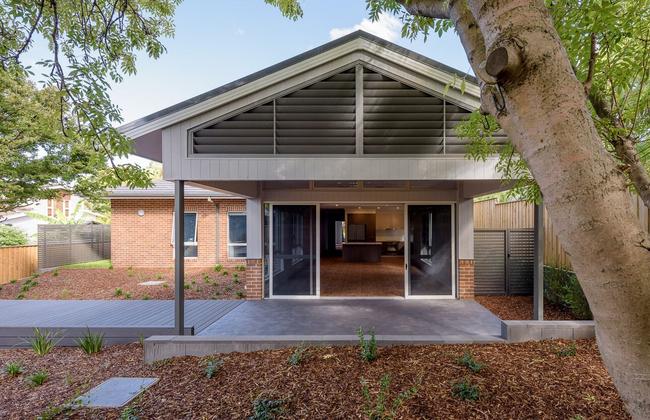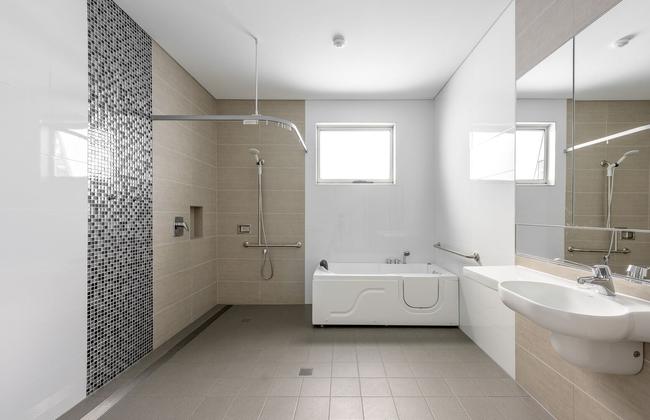Designing beautiful houses for all disabilities
DESIGNING for disability can deliver beautiful spaces as these three projects demonstrate.

Architects allows for easy wheelchair movement. Picture: Kilian O’Sullivan
Home Mag
Don't miss out on the headlines from Home Mag. Followed categories will be added to My News.
MOST of us wear our independence lightly. The ability to move freely and do things for ourselves is so second nature that we often take it for granted. But for those with mobility issues, getting through everyday tasks, from getting dressed in the morning to making a cup of tea at night, can be hard work.
Director of Liveable Housing Australia Nick Proud says Australia is still lagging behind countries such as Japan when it comes to designing easily accessible housing, also known as universal housing design.
“In Japan, they are third or fourth generation with their liveable housing designs but we’re getting there,” he says. “Ten years ago a five-star energy-rated house would have been difficult to get our heads around but things have changed.”

ON A ROLL
When Ashley Dunn from Dunn & Hillam was asked to renovate this house on the far South Coast (below) for a family of six to make it wheelchair friendly, the brief was to make it as accessible and beautiful as possible. One of the owners was permanently wheelchair bound following a cycling accident.
Ashley’s solution was to create a spacious open-plan living area overlooking the ocean, with seamless movement from indoor to outdoor areas. The kitchen has drawers rather than cupboards for easy access and there are two sinks — a deep one and a shallow version accessible from a seated position.
“We thought we should make the kitchen fully accessible for him so there was no excuse not to get in there and cook,” Ashley says.
While doorways are wider, the only giveaway that someone with mobility issues lives here is the grab rails in the bathroom.
“The bathroom is bigger than normal,” Ashley says.
“There’s a shower chair, which is also a commode, that packs into the cupboard next to the shower so he can roll in and out and he can move himself around.”
More: dunnhillam.com.au


GOING FOR GOLD
Director of Vista Access Architects Farah Madon says ABS figures indicate one in five Australians is living with a disability.
Liveable Housing Australia has developed three levels of housing that satisfy the criteria of universal housing design — silver, gold and platinum. New apartment building design guidelines stipulate that 20 per cent of all new apartments will now have to meet the minimum silver standard.
“This means that, in time, all new housing stock which is three storeys or more would have to provide minimum universal design features such as step-free access to at least one entry doorway, internal doors and passageways that are wider than usual, a visitable toilet on the entry level with some circulation space available in front of the pan (and) a hobless shower,” she says.
More: accessarchitects.com.au

MAKING MODIFICATIONS WORK
Designer Clare Le Roy from The Little Design Corner is mother to three boys, one of whom is confined to a wheelchair.
When she was renovating her own home on the north shore, she took a practical approach with his specific needs in mind. But needing more space for the chair had the potential to add to their building costs.
“Just squeezing everything we needed in to the extension size we could afford was the biggest sticking point,” she says. “And the bathroom size was one of the most difficult aspects. It was a perfectly OK size for a regular person but getting good circulation space for my son’s shower chair was tricky.”
Rather than modify the front of the house, which had steps up to their Californian bungalow, they extended the back of the house into their level garden.
Clare says when it comes to designing houses for people with disabilities, everyone’s needs are going to be different.
“Each person with a disability is different and has needs that are completely unique to their own situation and their own ability levels,” she says. “For my son, he is profoundly disabled and requires help for all of his daily needs, so his requirements will be completely different to someone who is able to live more independently.”
More: thelittledesigncorner.com
